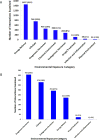Review of the Gene-Environment Interaction Literature in Cancer: What Do We Know?
- PMID: 27061572
- PMCID: PMC4911236
- DOI: 10.1002/gepi.21967
Review of the Gene-Environment Interaction Literature in Cancer: What Do We Know?
Abstract
Background: Risk of cancer is determined by a complex interplay of genetic and environmental factors. Although the study of gene-environment interactions (G×E) has been an active area of research, little is reported about the known findings in the literature.
Methods: To examine the state of the science in G×E research in cancer, we performed a systematic review of published literature using gene-environment or pharmacogenomic flags from two curated databases of genetic association studies, the Human Genome Epidemiology (HuGE) literature finder and Cancer Genome-Wide Association and Meta Analyses Database (CancerGAMAdb), from January 1, 2001, to January 31, 2011. A supplemental search using HuGE was conducted for articles published from February 1, 2011, to April 11, 2013. A 25% sample of the supplemental publications was reviewed.
Results: A total of 3,019 articles were identified in the original search. From these articles, 243 articles were determined to be relevant based on inclusion criteria (more than 3,500 interactions). From the supplemental search (1,400 articles identified), 29 additional relevant articles (1,370 interactions) were included. The majority of publications in both searches examined G×E in colon, rectal, or colorectal; breast; or lung cancer. Specific interactions examined most frequently included environmental factors categorized as energy balance (e.g., body mass index, diet), exogenous (e.g., oral contraceptives) and endogenous hormones (e.g., menopausal status), chemical environment (e.g., grilled meats), and lifestyle (e.g., smoking, alcohol intake). In both searches, the majority of interactions examined were using loci from candidate genes studies and none of the studies were genome-wide interaction studies (GEWIS). The most commonly reported measure was the interaction P-value, of which a sizable number of P-values were considered statistically significant (i.e., <0.05). In addition, the magnitude of interactions reported was modest.
Conclusion: Observations of published literature suggest that opportunity exists for increased sample size in G×E research, including GWAS-identified loci in G×E studies, exploring more GWAS approaches in G×E such as GEWIS, and improving the reporting of G×E findings.
Keywords: candidate gene; gene-environment interaction; genome-wide association study (GWAS); literature review.
Published 2016. This article is a U.S. Government work and is in the public domain in the USA.
Conflict of interest statement
The authors have no conflicts of interest to declare.
Figures



References
-
- Ambrosone CB, Kropp S, Yang J, Yao S, Shields PG, Chang-Claude J. Cigarette smoking, N-acetyltransferase 2 genotypes, and breast cancer risk: pooled analysis and meta-analysis. Cancer Epidemiol Biomarkers Prev. 2008;17(1):15–26. - PubMed
-
- Boffetta P, Winn DM, Ioannidis JP, Thomas DC, Little J, Smith GD, Cogliano VJ, Hecht SS, Seminara D, Vineis P, et al. Recommendations and proposed guidelines for assessing the cumulative evidence on joint effects of genes and environments on cancer occurrence in humans. Int J Epidemiol. 2012;41(3):686–704. - PMC - PubMed
-
- Brennan P. Gene-environment interaction and aetiology of cancer: what does it mean and how can we measure it? Carcinogenesis. 2002;23(3):381–7. - PubMed
-
- Centers for Disease Control. Gene-Environment Interaction Fact Sheet. Center for Disease Control and Prevention; 2000.
Publication types
MeSH terms
Grants and funding
LinkOut - more resources
Full Text Sources
Other Literature Sources
Miscellaneous

